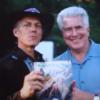Hallowe'en

The Roots of Hallowe’en (and Day of the Dead):
What’s it all about?
Why has the day of All Hallows Eve – Hallowe’en — devolved into a day of fun and fear? How was this once- Holy Day commemorated before it was all commercialized into a scary night? Is it possible to discover the roots of this day, and observe it in its original fashion today?
My circle of friends attempted to answer these questions. We determined that we’d need to dig up whatever historical facts we could find that show how this day was commemorated before 1700, more or less. Though we couldn’t be 100% certain, we at least assumed that “commercialization” didn’t really exist in 1700, and all the European and some American commemorations before that year probably retained some semblance of what the day was all about, originally.
Various sorts of activities done on Samhain have been described over the centuries. In Ireland, Samhain was a time to take stock of the herds and food supplies. Cattle were brought to the winter pastures after six months in the higher summer pastures. Then, the people chose which animals to slaughter before the winter. After the slaughter of the animals, there would be feasting. And obviously, if you aren’t an animal-raising farmer, how would you celebrate this aspect, except for the feasting?
In the 11th century, November 2nd was assigned as “All Souls’ Day” in commemoration of the dead. So this began the use of the term Hallow’s Eve, or Hallowe’en for October 31.
Hallowe’en customs are similar to the observance of Dia de los Muertos or Day of the Dead, commonly racticed in Mexico and which can be traced to early Aztec times. Apparently, this “day of the dead” was originally commemorated in Mexico in May, and was changed to November 2 sometime after Spanish contact, possibly to correspond with the “Christian” tradition.
FOOD and GIFTING
Trick or treating in modern times goes back to leaving food and wine for roaming dead spirits and ghosts. The custom was referred to as “going a-souling” and was eventually practiced only by the children who would visit the houses in their neighborhoods and be given gifts of ale, food and money. It was believed the spirits of the dead returned to visit their old homes during this time, so in ancient times, people left food out for them and arranged chairs so that the dead would be able to rest.
Treats called “soul cakes” were given out in memory of the departed. The Middle Age practice of souling — going door to door begging for food in return for prayers — became popular and is even referenced by William Shakespeare in 1593. This is obviously the root of the modern “trick or treating” for mini Snickers bars, a practice no doubt loved by every dentist.
Seasonal foods such as apples and nuts were often used in the Samhain rituals. Apples were peeled, the peel tossed over the shoulder, and its shape examined to see if it formed the first letter of the future spouse’s name. Nuts were roasted on the hearth and then interpreted – if the nuts stayed together, so would the couple. Egg whites were dropped in water, and the shapes foretold the number of future children. Children would also chase crows and divine some of these things from the number of birds or the direction they flew.
COSTUMES
Celts would wear masks when they left their homes during the night hours during Samhain days, because they hoped they would avoid being recognized by the ghosts and be mistaken merely for fellow ghosts.
“Mumming” and “Guising” were a part of Samhain from at least the 16th century and was recorded in parts of Ireland, Scotland, Mann and Wales. It involved people going from house to house in costume (or in disguise), usually reciting songs or verses in exchange for food. It is suggested that it evolved from a tradition whereby people impersonated the aos sí, or the souls of the dead, and received offerings on their behalf. Impersonating these spirits or souls was also believed to protect oneself from them. One researcher suggests that the ancient festival included people in masks or costumes representing these spirits, and that the modern custom came from this.
PARADES
Pagan Celtic priestesses and their followers would roam the countryside, chanting songs in order to frighten away the evil spirits thought to be out on Halloween night. I wonder how that could be practiced in your neighborhood?
FIRES
Bonfires were a big part of the festival in many areas of western Europe. Bonfires were typically lit on hilltops at Samhain where everyone could see them, and there were rituals involving them. We concluded that a small, safe backyard fire might be a good addition to celebrating the day, though we were pretty sure that local fire departments would take a very dim view if fires were built on local hilltops!
Bonfires comes from the root, “bone-fires” because the priests sacrificed animals and supposedly even people in an attempt to appease the sun god, while also looking for future omens. The fire was said to be a type of sympathetic magic, where the fire mimicked the sun, which has the power to hold back the darkness of winter. Burning the fires was also believed to be a way of banishing evil, at least symbolically.
DIVINATION
Divination has likely been a part of the festival since ancient times, and it has survived in some rural areas. In part, this meant that the spirits could enter your world. Many of the food offerings and fires were directed to these spirits. Or perhaps, some of the crops might also be left in the ground for them. These spirits were addressed in various ways, with food offerings, with walks into the ocean, with the idea to hold off any mischief, and perhaps to learn the future.
The belief that the souls of the dead return home on one night of the year seems to have ancient origins and is found in many cultures throughout the world.
CONCLUSION
So what do you conclude from all this? Is there an ideal way to commemorate this ancient day, and still avoid the trappings of commercialization? Is it even possible?
I like the way that the Day of the Dead is commemorated. There are altars with pictures of the dearly departed, and plates of good food. Candles are lit, rather than a big bonfire which the local fire department would frown upon. Families gather, and talk in respectful tones about their departed relatives. Yes, of course, even the Day of the Dead has turned into wild partying in some quarters, but if you seek a return to roots of the ancient commemoration of the dead, perhaps begin here.
Begin with family or neighborhood gatherings. Prepare a good meal, and keep in the mind the foods that your beloved departeds enjoyed. This is not necessarily because you think their spirits will come to eat (last I checked, ghosts don’t need to eat), but because having, for example, your mother’s favorite dish will give you another reason to talk about your mother, and to remember all the good things she did.
This is at least a start, and it elevates our day of ghoulish and pointless fear-mongering into one that reconnects us with our roots.
Source: http://christophernyerges.blogspot.com/2024/10/halloween.html
Anyone can join.
Anyone can contribute.
Anyone can become informed about their world.
"United We Stand" Click Here To Create Your Personal Citizen Journalist Account Today, Be Sure To Invite Your Friends.
Before It’s News® is a community of individuals who report on what’s going on around them, from all around the world. Anyone can join. Anyone can contribute. Anyone can become informed about their world. "United We Stand" Click Here To Create Your Personal Citizen Journalist Account Today, Be Sure To Invite Your Friends.
LION'S MANE PRODUCT
Try Our Lion’s Mane WHOLE MIND Nootropic Blend 60 Capsules
Mushrooms are having a moment. One fabulous fungus in particular, lion’s mane, may help improve memory, depression and anxiety symptoms. They are also an excellent source of nutrients that show promise as a therapy for dementia, and other neurodegenerative diseases. If you’re living with anxiety or depression, you may be curious about all the therapy options out there — including the natural ones.Our Lion’s Mane WHOLE MIND Nootropic Blend has been formulated to utilize the potency of Lion’s mane but also include the benefits of four other Highly Beneficial Mushrooms. Synergistically, they work together to Build your health through improving cognitive function and immunity regardless of your age. Our Nootropic not only improves your Cognitive Function and Activates your Immune System, but it benefits growth of Essential Gut Flora, further enhancing your Vitality.
Our Formula includes: Lion’s Mane Mushrooms which Increase Brain Power through nerve growth, lessen anxiety, reduce depression, and improve concentration. Its an excellent adaptogen, promotes sleep and improves immunity. Shiitake Mushrooms which Fight cancer cells and infectious disease, boost the immune system, promotes brain function, and serves as a source of B vitamins. Maitake Mushrooms which regulate blood sugar levels of diabetics, reduce hypertension and boosts the immune system. Reishi Mushrooms which Fight inflammation, liver disease, fatigue, tumor growth and cancer. They Improve skin disorders and soothes digestive problems, stomach ulcers and leaky gut syndrome. Chaga Mushrooms which have anti-aging effects, boost immune function, improve stamina and athletic performance, even act as a natural aphrodisiac, fighting diabetes and improving liver function. Try Our Lion’s Mane WHOLE MIND Nootropic Blend 60 Capsules Today. Be 100% Satisfied or Receive a Full Money Back Guarantee. Order Yours Today by Following This Link.






